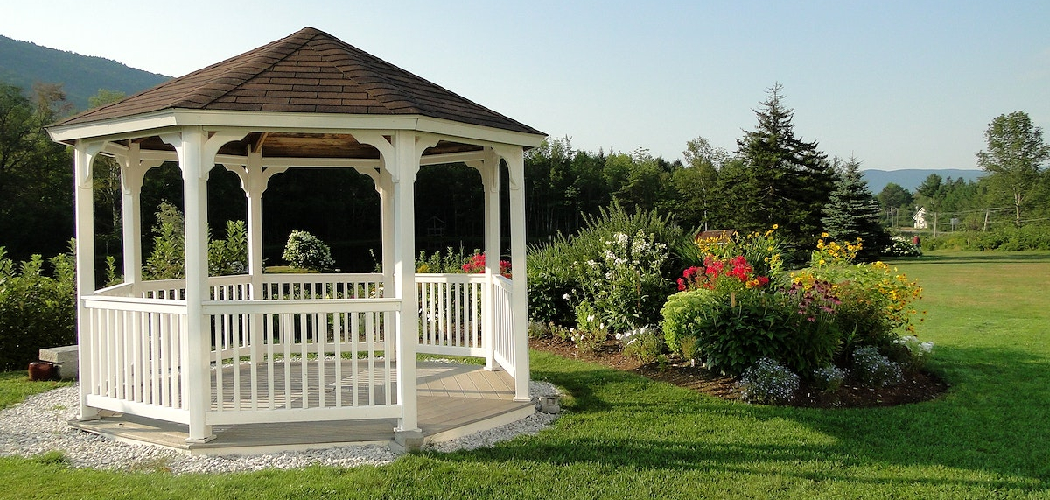Screening in a gazebo can transform it into a peaceful haven, shielding you from pesky insects while allowing you to enjoy the beauty of the outdoors without any disturbances. If you’re looking to create a bug-free and relaxing retreat in your gazebo, understanding how to screen it in is the key. In this article, we will guide you through how to screen in a gazebo, providing you with the information needed to turn it into a comfortable and inviting space.

From choosing the right materials and measuring accurately to framing, attaching screens, and adding finishing touches, we’ll cover it all. Whether you have a freestanding gazebo or one attached to your home, this comprehensive guide is suitable for both experienced DIY enthusiasts and those new to outdoor projects, allowing you to make the most of your gazebo year-round.
The Purpose of Screening a Gazebo
Whether you are spending the night outdoors or lounging in your backyard, a gazebo can provide the perfect outdoor shelter. However, it’s not always fun and games when dealing with bugs and pests that may interrupt your relaxation time. This is where screening comes in handy.
Screening a gazebo refers to attaching screens – typically made of metal mesh or synthetic fabric – around the perimeter of the gazebo to keep out unwanted insects and pests. This not only provides a more comfortable environment for you and your guests, but it also helps to protect any food or drinks from being contaminated by bugs.
But beyond keeping the bugs at bay, screening a gazebo has several other benefits that make it worth considering.
Improved Airflow and Ventilation
One of the main advantages of screening a gazebo is that it allows for improved airflow and ventilation. On hot summer days, the screens help to circulate the air inside the gazebo, keeping it cooler and more comfortable for everyone inside. This can be especially beneficial when hosting gatherings or events in your backyard.
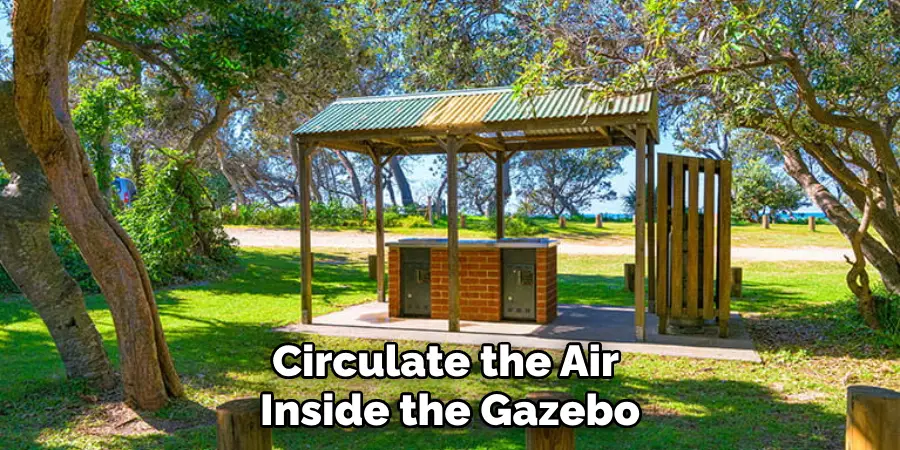
Additional Protection from Elements
Aside from bugs and pests, screens also provide an extra layer of protection from the elements. They can help to block out strong winds, dust, and debris, keeping your outdoor space cleaner and more enjoyable. Some screens also have UV-blocking properties, providing shade and protecting you and your guests from harmful sun rays.
10 Methods How to Screen in a Gazebo
1. Shade Cloth
One of the simplest and most affordable ways to screen in a gazebo is to use shade cloth. Shade cloth is a lightweight fabric that can be stretched over the top of the gazebo to provide protection from the sun and wind. It also comes in a variety of colors, so you can choose one that best matches your gazebo and outdoor space. Additionally, shade cloth is easy to install and can be removed for cleaning or when not in use.
2. Mosquito Netting
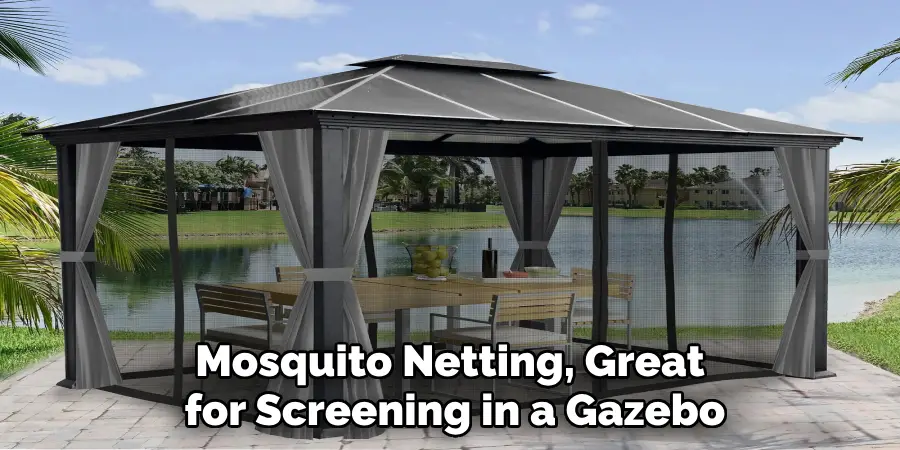
Mosquito netting is another great option for screening in a gazebo. This type of netting is made from a fine mesh material that will keep out pesky bugs while still allowing air to circulate freely inside the gazebo. Plus, mosquito netting comes in several different sizes and shapes, so you can find one that fits your gazebo perfectly.
3. Retractable Screens
If you want more flexibility with your screening options, then retractable screens may be the way to go. These screens are made from a durable vinyl material and come with an easy-to-use roller system that allows you to quickly open or close them as needed. They are also available in several different sizes and colors, so you can find one that complements your gazebo’s style perfectly.
4. Roll-Up Shades
Roll-up shades are another great option for screening in a gazebo as they provide privacy without blocking out too much light or air flow. They come in several different materials such as canvas or vinyl, so you can choose one that best suits your needs and budget. Plus, roll-up shades are easy to install and maintain, making them an ideal choice for those who don’t want to spend too much time setting up their screening solution.
5. Bamboo Blinds
Bamboo blinds offer an attractive way to screen in a gazebo while providing plenty of privacy at the same time. These blinds come in various sizes and styles, so you can easily find one that fits your space perfectly. Additionally, bamboo blinds are relatively inexpensive compared to other types of screening solutions, making them an attractive choice for those on a budget.
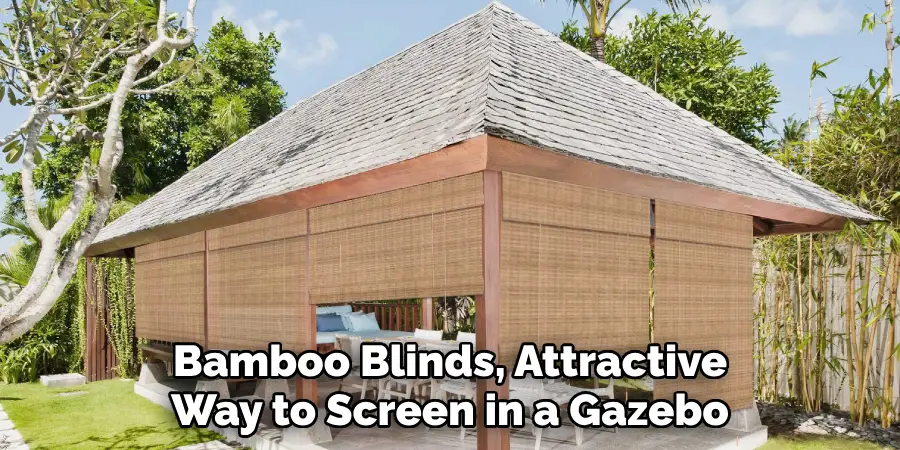
6. Window Film
Window film is another great way to screen in a gazebo without sacrificing visibility or airflow inside the structure. This type of film comes in many different designs and colors, so it’s easy to find one that matches your decor perfectly while still providing ample privacy during outdoor gatherings or events. Plus, window film is relatively easy to install yourself if desired!
7. Plantings
Plantings such as trees or hedges are another popular method for screening in a gazebo as they provide both natural beauty and privacy at the same time! Trees should be planted at least 8 feet away from the structure itself, while shrubs should be planted around 3 feet away from it; this will ensure enough room for growth as well as adequate airflow around the structure itself! Additionally, these plantings require little maintenance after being installed, which makes them an ideal choice for those who don’t have much free time on their hands!
8. Outdoor Curtains
Outdoor curtains offer yet another way to screen off your gazebo while still allowing plenty of light into the area during daytime hours! Outdoor curtains come in various materials such as canvas or polyester, which makes them both durable and stylish; plus, they’re relatively inexpensive compared with other types of screening solutions! Additionally, outdoor curtains are easy to hang up with simple curtain rods, which makes installation quick and painless!
9. Trellises
Trellises are an attractive way to add some height (and therefore more privacy) around your gazebo without taking up too much space; they also provide support for climbing plants such as vines which adds even more visual interest! Trellises come in many different shapes and sizes, so it’s easy to find one that fits perfectly into any outdoor space; plus, they require minimal upkeep once installed, which makes them ideal for busy homeowners who don’t have much time on their hands!
10. Fencing
Finally, fencing is another great option if you need extra security or complete privacy around your gazebo; plus, it provides added safety by keeping pets (and children!) away from potentially hazardous areas like pools or hot tubs!
Fencing comes in many different materials, such as wood or metal, which allows you to customize its look according to your own personal taste; plus, it requires minimal maintenance after being installed, which makes it an ideal choice for those who want a long-lasting and hassle-free screening solution!
Things to Consider When Screen in a Gazebo
When it comes to spending time outdoors, a gazebo can be a great addition to any backyard or garden. Not only does it provide shade and shelter, but it also adds an extra touch of style and elegance to your outdoor space. However, as with any outdoor structure, you may want to consider screening in your gazebo for added protection from insects and other outdoor elements.
Here are some factors to consider when deciding whether or not to screen in your gazebo:
Climate and Location
Before making any decisions, it’s important to take into account the climate and location of where your gazebo is situated. If you live in an area with a lot of bugs or mosquitoes, screening can be a great way to enjoy your gazebo without being bothered by pesky insects. On the other hand, if you live in a windy area or experience frequent storms, screening may not be the best option as it can easily get damaged.
Purpose and Usage
Consider how you plan on using your gazebo. If you envision it being used primarily for outdoor dining or entertaining, then screening may be beneficial in keeping unwanted pests away from your guests. However, if you plan on using your gazebo as a quiet reading nook or meditation space, you may prefer to leave it open and enjoy the natural surroundings.
Maintenance and Upkeep
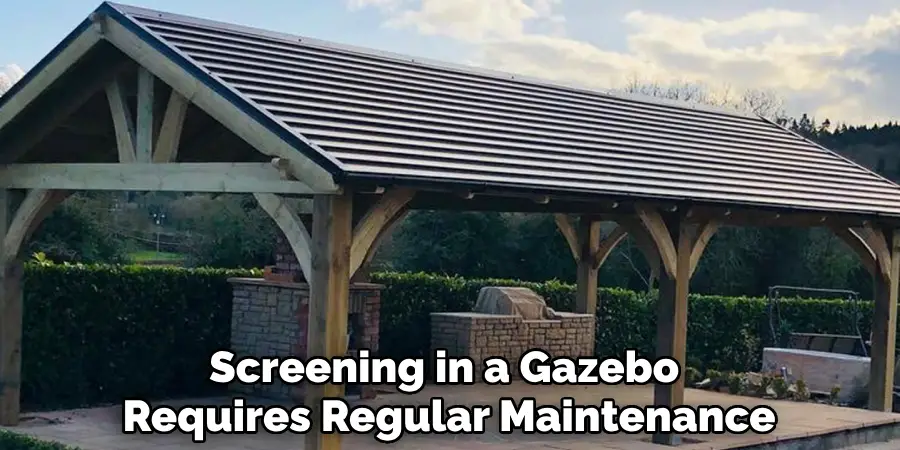
Screening in a gazebo requires regular maintenance and upkeep to ensure that it remains in good condition. This includes replacing torn screens, cleaning debris and dirt off of the screens, and potentially having to repair or replace the entire screen enclosure.
Conclusion
In conclusion, learning how to screen in a gazebo can be both challenging and rewarding. From deciding the type of materials you’ll need to purchase, right through to fitting the panels into place – it can take days of effort if done properly.
However, once complete, it looks amazing and your outdoor area will now become much more pleasant. Don’t forget to consider weather-resistant paneling, tools and fixings, too! That way, when the unpredictable British weather rolls by, you won’t have any damage caused by wind or rain. So break out the toolbox and get started today!

